The Solar System Contains Heavy Elements, Formed From an Earlier Generation of Stars
How did the solar system form? How were its varied building blocks of rock, metal, ice, and gas created? How has the solar system changed since its formation, and what does its history tell us about the planets as they are today? Within the past few decades, telescopes and space probes, along with the theories of modern science and computer simulations of these theories, have finally provided some of the answers to these age-old questions.
5-1 Stars transform matter from lighter elements into heavier ones
Our study of the formation of the solar system begins with an inconsistency, namely that Earth, the Moon, and many other objects that orbit the Sun are composed primarily of heavy elements including (among many others) oxygen, silicon, aluminum, iron, carbon, and calcium. (Note that we capitalize the word moon only when we are referring to Earth’s Moon.) Furthermore, most of these bodies contain extremely little hydrogen and helium. However, observations of the spectra of the Sun, other stars, and interstellar clouds reveal that hydrogen and helium are by far the most abundant elements in the universe. These two elements account for about 99.9% of all observed atoms (or, equivalently, 98% of observed mass). All of the other elements combined account for about 0.1% of the observed atoms (and, hence, 2% of the observed mass of the universe). How is it that Earth, the Moon, Mars, Venus, Mercury, and many smaller bodies in the solar system typically contain less than 0.15% hydrogen and helium? Somehow, these familiar astronomical objects formed from matter that had been enriched with the heavier elements and depleted in hydrogen and helium.
There is a good reason for the overwhelming abundance of hydrogen and helium throughout the universe. Astronomers believe that the universe formed about 13.8 billion years ago in a violent event called the Big Bang. This event created not only all the matter and energy that exists but also space and time. (We explore these issues in Chapter 18.) Only the lightest elements—hydrogen, helium, and a tiny amount of lithium—were created in the process. These first elements came into existence as gases. The first stars, composed only of these three elements, condensed out of this primeval matter within a few hundred million years after the Big Bang occurred.
133
 The difference in chemical composition between the gas and stars in the early universe and the solar system today shows that the solar system did not form as a direct result of the Big Bang. Rather, as we shall see shortly, the solar system formed some 9 billion years after the universe came into existence. Let us briefly explore the chemical transformations that led to our being here, which began deep inside those first stars. Once stars form, gravity compresses the matter in their central cores so much that the hydrogen there is transformed into helium in a process called thermonuclear fusion (fusion, for short). Hydrogen fusion has the interesting property that some of the hydrogen’s mass is converted into electromagnetic energy (photons), a portion of which eventually leaks out through the star’s surface, enabling it to shine. (That is why the Sun shines.) The core’s helium subsequently fuses to create carbon and oxygen, also converting some mass into energy. If the star has enough pressure in its core, these elements transform into even heavier elements, including neon, aluminum, silicon, calcium, and iron, while other elements are fused in shells surrounding the core. We explore details of the creation of these heavier elements in Chapters 12 and 13.
The difference in chemical composition between the gas and stars in the early universe and the solar system today shows that the solar system did not form as a direct result of the Big Bang. Rather, as we shall see shortly, the solar system formed some 9 billion years after the universe came into existence. Let us briefly explore the chemical transformations that led to our being here, which began deep inside those first stars. Once stars form, gravity compresses the matter in their central cores so much that the hydrogen there is transformed into helium in a process called thermonuclear fusion (fusion, for short). Hydrogen fusion has the interesting property that some of the hydrogen’s mass is converted into electromagnetic energy (photons), a portion of which eventually leaks out through the star’s surface, enabling it to shine. (That is why the Sun shines.) The core’s helium subsequently fuses to create carbon and oxygen, also converting some mass into energy. If the star has enough pressure in its core, these elements transform into even heavier elements, including neon, aluminum, silicon, calcium, and iron, while other elements are fused in shells surrounding the core. We explore details of the creation of these heavier elements in Chapters 12 and 13.
Margin Question 5-1
Question
Which elements on Earth may have been unchanged since the universe began?
Stars also shed matter into space (Figure 5-1). Some of the heavy elements that formed inside them, specifically those elements created in the shells of fusion occurring outside their cores, are eventually ejected, along with most of the hydrogen and helium remaining in their outer layers. The outer layers of stars are expelled at different rates, ranging from continuous outflows called stellar winds (Figure 5-1a), to the more energetic planetary nebulae (so named not because they have any direct connections to real planets, but rather because they looked like planets in early, low-resolution telescopes) (Figure 5-1b), to spectacular detonations called supernovae (Figure 5-1c). Supernovae are such powerful events that fusion occurs during these explosions, creating even denser elements than iron that are also expelled from the star. Planetary nebulae and supernovae leave only tiny, dim, but very hot stellar cores, remnants of once-mighty stars.
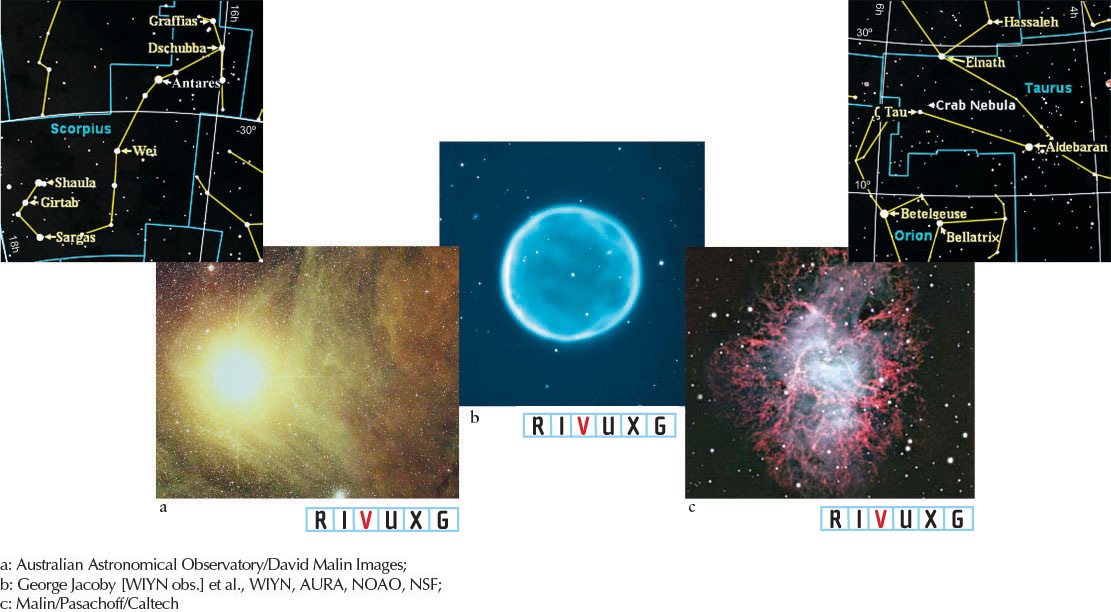
134
Of the matter ejected from stars, some leaves as small particles of dust, similar to the soot formed in a fire or in diesel exhaust. This dust is typically a millionth of a meter (a micron) in size. Over time, enough gas and dust were emitted by enough stars to form interstellar clouds rich in hydrogen and helium, but which also contained small amounts of metals. (In a curious alternative use of a common word, astronomers define metals to be all of the elements in the universe other than hydrogen and helium.) Some of the atoms in these clouds also combine to form molecules of, for example, water, carbon dioxide, methane, and ammonia. We will turn next to these clouds in order to understand the formation of the solar system and why dense planets like Earth are so rich in metals and poor in light elements.
5-2 Gravity, rotation, collisions, and heat shaped the young solar system
Observations of clouds in which stars are forming today, such as the Cone Nebula and the nearby Orion Molecular Cloud (Figure 5-2 and the image that opens this chapter), reveal that most stars form inside giant interstellar clouds of gas and dust. Between a few and a few thousand stars typically form at the same time in these clouds, creating groups called open clusters. It is likely that the solar system formed in such a cluster. Stars in open clusters are not gravitationally bound to each other, and they eventually drift apart, which is why even the closest stars to the solar system are light-years away from us today.
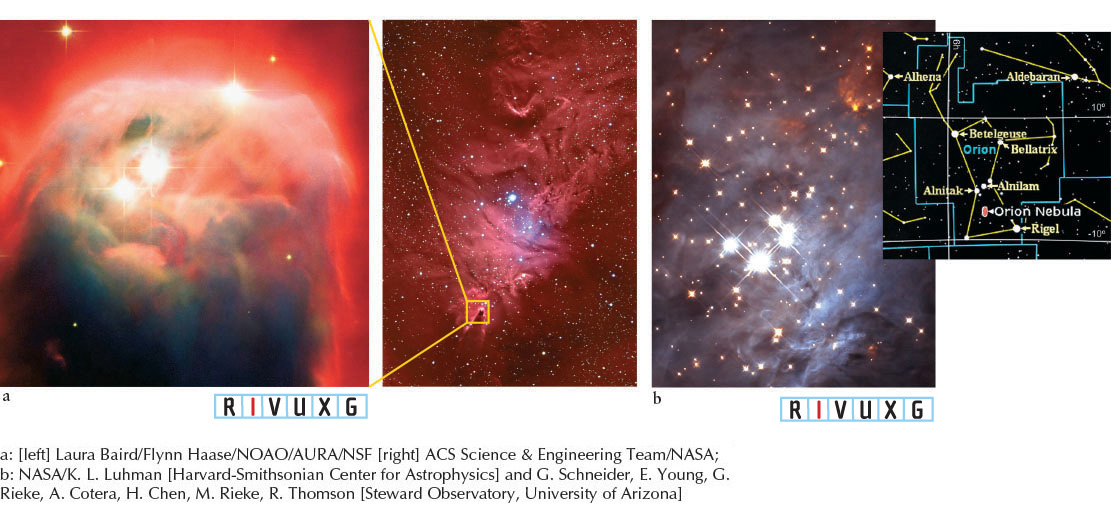
Such clouds do not spontaneously collapse to form stars because the particles in these clouds are moving fast enough (meaning they are warm enough, since motion is a measure of how hot gases are) to avoid being pulled together by their mutual gravitational attraction. Another way to say this is that the gases comprising these clouds have high enough internal pressures to prevent them from collapsing together and forming stars. Pressure is the force that the gas exerts on any area of either itself or anything else (think of the pressure that the gas in a balloon exerts on the surface of the balloon to keep it inflated).
With sufficiently low temperature and pressure and sufficiently high gas density, however, fragments of clouds collapse under the influence of their own gravitational attraction. We say that each of these regions has a Jeans instability, after the British physicist Sir James Jeans (1877–1946), who calculated the necessary conditions for such collapse in 1902. Pieces of interstellar clouds become “Jeans unstable,” allowing stars and their hosts of orbiting bodies to form, for at least three reasons. First, winds from nearby stars compress gas and dust in the cloud. Second, the explosive force of a nearby supernova compresses regions of gas and dust. Third, pairs of clouds collide and compress each other. Each collapsing fragment destined to become a star (or a pair of stars orbiting each other called a binary star system) and possibly planets is called a dense core.
135
Some chemical evidence in space debris that we have analyzed on Earth suggests that the dense core in which our solar system formed may have become Jeans unstable when its gas and dust were hit by the shock wave from a supernova. We call that dense core the solar nebula (also called the proto-solar or pre-solar nebula).
Many of the concepts in what follows comprise the Nice model (pronounced like “niece” and named after the city in France where it was first developed) of the formation of the solar system. This model is based on computer simulations of the evolution of the outer regions of the solar nebula. We are in an epoch of astronomical research in which insights into the process by which the solar nebula transformed into the Sun and its host of orbiting bodies are coming at an unprecedented rate. The details of this theory are tentative and are likely to evolve as simulations become more realistic and more solar system debris left over from the formation process is analyzed. Therefore, the following scenario is a prime example of how science is a work in progress, rather than a presentation of complete understanding of nature.
The solar nebula initially had a diameter of at least 1000 AU (1000 times the average distance from Earth to the Sun) and a total mass about 2 to 3 times the solar system’s present mass (Figure 5-3). At first that nebula was a very cold collection of gas and dust—well below the freezing point of water. Although most of the solar nebula was hydrogen and helium, ice and ice-coated dust grains composed of heavy elements were scattered across this vast volume. Deep inside the nebula, gravitational attraction caused gas and dust to fall rapidly toward its center. (In terms of the physics presented in Chapter 2, the cloud’s gravitational potential energy was being converted into kinetic energy—energy of motion.) As a result, the density, pressure, and temperature at the center of the nebula began to increase, producing a concentration of matter called the protosun.
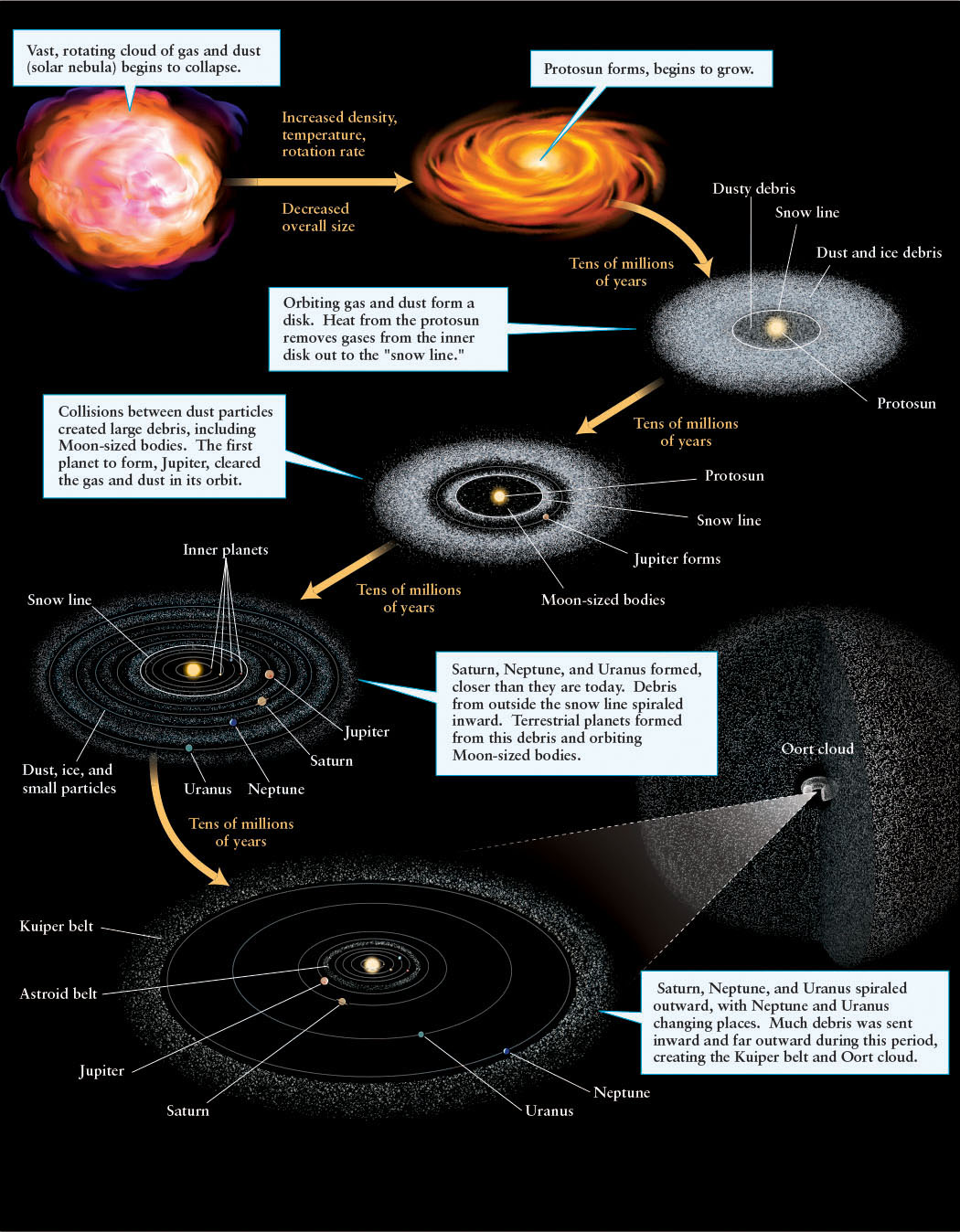
As the protosun continued to increase in mass and to contract, atoms within it collided with increasing speed and frequency. This activity created growing pressure inside the protosun, which caused its contraction to slow dramatically. Such collisions also created heat, causing the protosun’s temperature to soar. Therefore, the first heat and light emitted by our Sun came from colliding gas, not from thermonuclear fusion, as it does today. At the same time, there was also considerable activity in the outer regions of the disk.
Insight Into Science: Computer-Aided Analysis
Many equations are so complex that they require computer analysis to enable us to understand their implications. For example, the study of the physics of the formation of the planets and the Sun began with observations, which then led to the Nice model, which uses ever more sophisticated computer simulations to reveal the early evolution of the solar system.
Rotation played a key role in the formation of the solar system. When it first developed, the solar nebula was a very slowly rotating ensemble of particles. This rotation occurred because the formation of interstellar clouds is turbulent, so these clouds are created with many slowly swirling regions, like smoke rising from a fire. As a result of this rotation, the solar nebula, created from one of these slowly swirling regions, had angular momentum (see An Astronomer’s Toolbox 2-2: Energy and Momentum). Because angular momentum is conserved (see Section 2-7), rotating matter spiraling inward in the young solar nebula revolved faster and faster, like the skater in Figure 2-12 when she pulls her arms in. This motion had the effect of flattening the nebula into a disk. You can see an analogous effect of rotation in the way the ice skater’s dress in Figure 2-12 is forced into a plane as she spins. (Had the solar nebula been nonrotating, it would have collapsed en masse to create a star without any planets or other orbiting matter.) Even the debris in the inner solar nebula that formed the protosun was orbiting as it fell inward, like water spiraling before it goes down a drain. Therefore, the protosun was spinning and the Sun that formed from it rotates. We will discuss the Sun’s rotation further in Chapter 10.
The outer region of the young solar nebula was probably very ragged, but mathematical studies show that the combined effects of gravity, collisions, and rotation would transform even an irregular dense core into a rotating disk with a warm center and outer cold edge about 30 AU from the protosun (see Figure 5-3). Eventually, the gas and dust in the disk of the solar nebula were orbiting fast enough to stop spiraling inward.
Although we cannot see our solar system as it was before planets formed, astronomers have found what we think are similar disks of gas and dust surrounding other young stars, including those shown in Figure 5-4. Called protoplanetary disks, these systems are undergoing the same initial stage of evolution that we have described here for our solar system.

 RIVUXG Young Circumstellar Disks of Matter The heart of the Orion Nebula as seen through the Hubble Space Telescope. The four insets are false-color images of protoplanetary disks within the nebula. A recently formed star is at the center of each disk. The disk in the upper right is seen nearly edge-on. Our solar system is drawn to scale in the lower left image.
RIVUXG Young Circumstellar Disks of Matter The heart of the Orion Nebula as seen through the Hubble Space Telescope. The four insets are false-color images of protoplanetary disks within the nebula. A recently formed star is at the center of each disk. The disk in the upper right is seen nearly edge-on. Our solar system is drawn to scale in the lower left image.
As occurs with all gases, the protosun’s temperature increased as it became denser. As the protosun radiated more and more heat, the temperature around it began to increase. The protosun’s increasing temperature vaporized all common icy substances (including carbon dioxide, water, methane, and ammonia) in the inner region of the disk. These gases then blew away, along with the abundant hydrogen and helium gas that also initially existed there. Within a hundred thousand years or so of the disk forming, no gases or ices orbited closer than roughly 3 AU, between what are now the orbits of Mars and Jupiter. Temperatures were low enough beyond this distance that gases, primarily hydrogen and helium, and ices remained in orbit around the protosun. The boundary beyond which these gases and ices of water, carbon dioxide, methane, and ammonia persisted is called the snow line (or frost line or ice line). Within a million years of when the Jeans instability occurred, the solar system had differentiated into an inner region containing just metal-rich dust grains (that are not easily vaporized) and an outer region rich in hydrogen gas, helium gas, and ice-covered dust particles.
136
137
Neighboring dust grains beyond the snow line began colliding with each other. The early motion of this debris was very chaotic; many of these collisions caused dust grains to grow, while many other collisions broke apart larger pieces of this debris. When dust particles finally reached sizes of a few millimeters, they began plowing through the surrounding gas. As the dust particles pushed aside this gas, the gas took energy away from (that is, slowed down) the dust particles, much as you slow down when walking into a headwind. As a result of losing energy (slowing down), this dust spiraled inward toward the protosun. The collision and accretion—the coming together of smaller pieces of matter to form larger ones—of dust particles continued as they spiraled inward. Through accretion, the dust grew into pieces of debris meters across. Calculations show that a piece of debris a meter across could have spiraled inward to half its original distance from the protosun in just 1000 years! Collisions destroyed some of these bigger bodies, while some of them merged and grew even larger. Eventually, a few billion of these boulders reached dimensions of a kilometer or so, large enough for their mutual gravitational attractions to enhance the rate at which they collided. Such pieces of debris are called planetesimals.
Margin Question 5-2
Question
What force ensured that once the solar nebula began collapsing, it continued to do so?
The formation of planetesimals was a turning point in the young solar system’s evolution. They collided with countless dust particles as well as with each other. Sometimes colliding planetesimals destroyed each other, and returned to myriad pieces of dust. Eventually, however, these collisions led to the growth of several hundred substantial bodies that persisted and eventually reached the size and mass of our Moon. At this size, the gravitational attraction of the planetesimals was strong enough for them to either sweep up the surrounding rubble or to fling it far away, thereby clearing out nearby space and limiting their own growth. These bodies led to the formation of the terrestrial planets, to which we will return shortly.
5-3 The giant planets formed in sequence
Jupiter
Many planetesimals were also formed out beyond the snow line and in substantially noncircular orbits. As a result, they crossed paths and a few of them collided and merged with each other out there, creating larger bodies. One planetesimal located 1 or 2 AU beyond the snow line accreted enough of its companions to become an Earthlike body containing perhaps 10 Earth masses of rock and metal. This body had enough gravitational attraction to pull onto itself vast amounts of the hydrogen, helium, and ices that existed near its orbit. Within only a few thousand years of forming, it grew into the planet Jupiter. Like the heating of the protosun, impacts from infalling gases heated Jupiter up; in fact, the planet was heated so much that for a short time it outshone the protosun.
138
Plowing through the surrounding gas and dust, the growing Jupiter lost energy and was thereby forced to spiral inward. Calculations suggest that it may have reached as close as Mars’s present orbit before it stopped its migrating toward the protosun. On the way in, Jupiter’s gravitational attraction and the heat it emitted stirred up the surrounding gas enough so that some of the gas and dust it passed was sent inward toward the protosun and some was sent outward. In this way, Jupiter eventually “cleared its neighborhood,” and its growth halted. By this point, Jupiter had accumulated about 300 Earth masses of hydrogen and helium, plus several Earth masses of water and other simple molecules. From the inside out, Jupiter was a rocky world, surrounded by a layer of water, which was surrounded in turn by a much thicker layer of predominantly hydrogen and helium. Jupiter rotates today because it formed from swirling debris in the solar nebula. Likewise, all the other planets in our solar system rotate.
Jupiter’s inward migration had two long-term effects on our solar system. First, as it passed through what is now the asteroid belt, it dispersed most of the debris there, preventing a planet from ever forming in that region. Second, it had a similar, but not quite as effective, influence on stirring up the debris in the vicinity of what is now Mars’s orbit. Astronomers believe that is why Mars is such a low-mass planet compared to Earth and Venus. As we will discuss shortly in more detail, many Jupiterlike planets orbiting other stars are even closer to their stars than Mercury is to the Sun. Jupiter is likely to have continued inward as it plowed through the surrounding gas and dust if it had not been stopped by the gravitational attraction of the next planet to form, Saturn.
Saturn
Margin Question 5-3
Question
What two elements comprise most of Saturn’s outer layer?
A few million years after Jupiter formed, collisions of planetesimals led to the formation of a second rocky world of about 10 Earth masses located a few astronomical units out beyond Jupiter. This second world underwent the same process of accreting hydrogen, helium, and ice, thereby creating Saturn. By the time Saturn formed, however, a lot of gas in its vicinity had already been stirred up and dissipated by Jupiter, leaving Saturn with less matter to accrete. Saturn has about 80 Earth masses of hydrogen and helium, along with a few Earth masses of water. Note that when it formed, Saturn was closer to the protosun than it is to the Sun today. Furthermore, the gravitational attraction of the young Saturn, combined with that of Jupiter, cleared their neighborhoods of the gas and dust that were causing them to spiral inward. As a result of their gravitational interaction with each other, they both spiraled back out until Jupiter arrived at its present location, with Saturn farther out.
Neptune and Uranus
The gravitational effects of Jupiter and Saturn forced many planetesimals to become concentrated out beyond Saturn’s orbit, leading to the formation of two more rocky planets destined to become the cores of Neptune and Uranus. The debris that far from the protosun had been spiraling inward for several million years; thus, these two planets are believed to have formed substantially closer to Saturn than they are today. Furthermore, computer simulations suggest that at the time of their formation, Neptune was closer to the protosun than Uranus (the opposite of their positions now!).
While substantial ice remained for Neptune and Uranus to collect, they formed so late that Jupiter and Saturn had dissipated most of the hydrogen and helium in their neighborhoods. Therefore, Neptune and Uranus became rich in water, along with carbon dioxide, methane, and ammonia—generically called “ices”—from their surroundings, but each accreted only a couple of Earth masses of hydrogen and helium. While Jupiter and Saturn are called gas giants, Neptune and Uranus are called ice giants.
5-4 The inner planets formed primarily from collisions
The details of how the inner four rocky planets—Mercury, Venus, Earth, and Mars—formed are less well known than for the giant planets just discussed. It appears likely that the inner planets formed as a result of collisions between the Moon-sized and larger planetesimals discussed at the end of Section 5-2. Within 100,000 years of the dust beginning to coalesce and to spiral inward, as described above, bodies with 0.1 Earth masses were able to form in it and collide with each other inside the snow line. It is unknown whether most of these planetesimals formed inside the snow line in relatively circular orbits and then collided to build planets in relatively circular orbits, or whether the four inner worlds formed from collisions of planetesimals that came from beyond the snow line in highly elliptical orbits that then somehow became circular. Whether the inner planets formed in orbits near their present average distances from the Sun or whether they migrated inward, like the planetesimals outside the snow line described above, is also unknown.
In the end, however, the collisions of hundreds of Moon-sized planetesimals led to the existence of four rocky inner planets: Mercury, Venus, Earth, and Mars (Figure 5-5). We are literally made of stardust! Because these planets were located inside the snow line, they did not acquire coatings of hydrogen and helium like those still found on the giant planets today. However, enough hydrogen and helium were part of the debris that formed the inner four planets that these gases became their first atmospheres. Being so light, these gases quickly drifted into space, as we explore further in the next chapter.
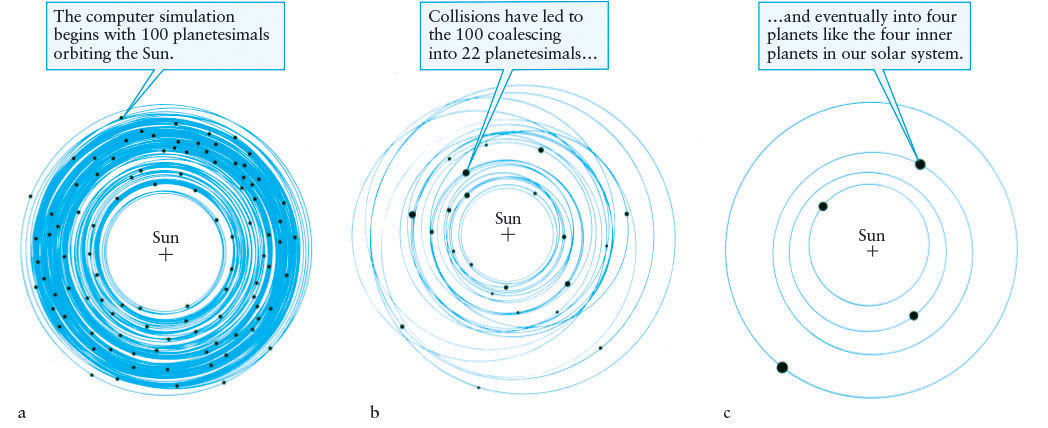
139
Because Mercury, Venus, and Mars have similar densities as Earth (in Latin, terra), they are composed of similar chemicals. Consequently, all four bodies are called terrestrial planets.
The large quantities of water that exist on Earth today, that existed on Mars, and that are likely to have existed briefly on Venus came in part from ices in the planetesimals that created these worlds and in part from impacts of water-rich debris called comets. Thus, the Nice model shows how our world came to have so much metal and so little hydrogen and helium, as proposed earlier in the chapter.
One planetesimal impact on the young Earth was particularly notable. When the young Earth had between 80% and 90% of its present mass, it was struck by a planetesimal with a mass that may have been as large as that of Mars (10% of Earth’s present mass). Computer simulations of such an impact indicate that it would have splashed a lot of debris off Earth’s surface and into orbit and tilted Earth’s rotation axis. This event occurred about 4.5 billion years ago, within 100 million years after Earth started forming. The orbiting debris created a short-lived ring, which clumped together (in a process analogous to how planetesimals grew from collisions) and formed our Moon.
5-5 The changing orbits of the giant planets spread debris throughout the solar system
The Nice model also provides interesting insights into the evolution of the outer solar system after the four giant planets were formed. These planets were so much more massive than the surviving planetesimals with which they orbited that they were able to gravitationally fling some of this remaining debris toward the inner solar system. To do so while conserving energy and angular momentum, the planets had to spiral outward in response. Lower-mass Saturn spiraled outward faster than Jupiter. Recall from Kepler’s third law (Section 2-5) that as planets move farther from the Sun, the periods of their orbits lengthen. Eventually, Saturn reached a distance where it orbited the Sun once every time Jupiter orbited twice. This situation, where the periods of two orbits are related by whole numbers, is called a resonance because the resulting gravitational interactions between the two bodies reinforce each other. The process is analogous to pushing someone on a swing—if you push at the right time (that is, in resonance with the person’s motion), they will go higher and higher.
As Saturn passed through this distance, resonant tugs from Jupiter pulled Saturn forward in its orbit, giving Saturn energy that enabled it to rapidly spiral outward. Approaching Neptune and Uranus, Saturn’s gravitational attraction in turn gave these bodies extra strong tugs, which in turn forced them to spiral out much farther away from the Sun than they were originally. Recall that Neptune formed closer to the young Sun than Uranus. Because it was closer to Saturn during this transformative period, Neptune received stronger gravitational tugs from Saturn (and Jupiter) than did Uranus. As a result, Neptune was forced out past Uranus.
At that time there were still billions of planetesimals in the realm of the giant planets. The gravitational effect of the outwardly moving planets caused most of these planetesimals to change orbits. Some were sent inward, but most were hurled into orbits much farther away from the Sun than they had been. The outward flying planetesimals spread way beyond the original disk (which had a radius of 30 AU, as noted above). Billions of them were flung into a bagel-shaped volume beyond the orbit of Neptune that is now called the Kuiper belt (Figure 5-6), named after Gerard Kuiper (1905–1973), who first proposed the existence of such a region in 1951. Many more planetesimals were sent out even further than the Kuiper belt, creating a spherical distribution of debris called the Oort cloud.
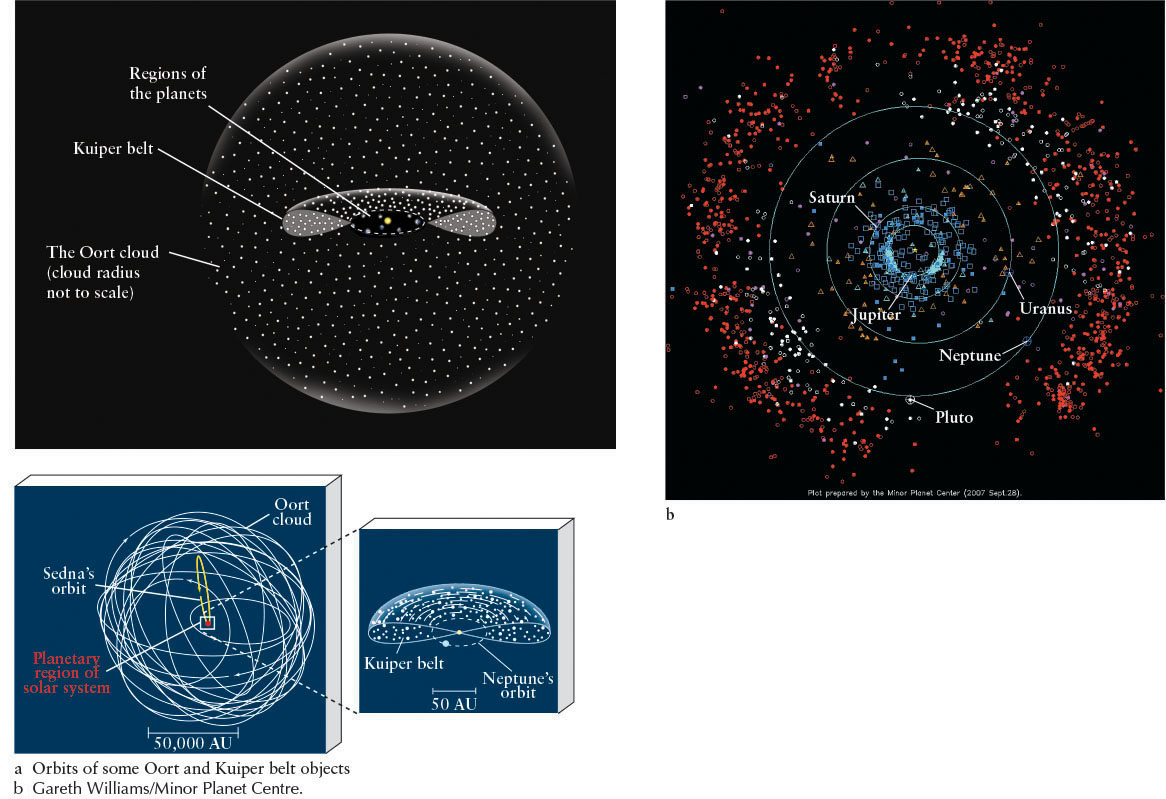
140
Kuiper belt objects, or KBOs, were first observed in 1992. Most of the Kuiper belt objects are ice-rich comets. Some of them have developed highly elongated orbits that occasionally bring them closer to the Sun than Earth’s orbit. When this happens, the Sun’s radiation vaporizes some of their ices, producing the long, flowing tails that we associate with comets.
Kuiper belt objects are distributed from about 30 AU to about 50 AU from the Sun. At least 1500 of them have been cataloged. The smallest Kuiper belt object observed so far, discovered using the Hubble Space Telescope in 2009, is only 1 km across. Astronomers believe that there are many Kuiper belt objects much smaller than this. Even nonscientists, however, are familiar with one of several large bodies that the giant planets flung out—Pluto. Pluto became locked in a 2:3 resonant orbit with Neptune, meaning that it orbits the Sun twice in the same time that Neptune orbits 3 times. The gravitational effects of resonances are so pronounced that thousands of other bodies, called plutinos, have the same type of resonant orbit around the Sun (two orbits of each plutino for every three orbits of Neptune) as does Pluto. Astronomers have observed several other bodies similar in size to Pluto that were also flung far into the Kuiper belt. All bodies orbiting beyond Neptune that have enough mass to pull themselves into spherical shape are called plutoids. Pluto is one such body.
The Oort cloud extends out perhaps 50,000 AU, a quarter of the way to the nearest star (see Figure 5-6). Most bodies in that distribution are believed to be a few kilometers in size or smaller. One candidate Oort cloud object, Sedna, is in an extremely elliptical orbit (Figure 5-6a), taking it between 76 and 976 AU. All the objects that orbit the Sun farther than Neptune are called trans-Neptunian objects, or TNOs. Plutinos and plutoids are examples of TNOs.
141
5-6 The asteroid belt is leftover debris
Now we turn to the major reservoir of leftover debris remaining in the inner solar system, the asteroid belt, located between Mars and Jupiter. Orbiting in this region are millions of planetesimals and smaller pieces of debris. The total mass of debris in the asteroid belt is about 5% of our Moon’s mass, much less than the mass of a planet. There were more bodies in the asteroid belt in the distant past, but impacts and the gravitational tug of Jupiter pulled some bodies away and kept the remaining debris spread out, thereby preventing it from ever coming together to form a larger body.
The largest asteroid, Ceres, has a diameter of about 900 km (compared to Earth’s diameter of 12,756 km). It was the first asteroid discovered, in 1801. The next largest, Vesta and Pallas, are each about 500 km in diameter. Still smaller asteroids are increasingly numerous. Many thousands of kilometer-sized asteroids have been observed. A close-up picture of the asteroid Gaspra is shown in Figure 5-7. Some asteroids have their own moons, such as the asteroid Ida, which is orbited by heavily cratered Dactyl.
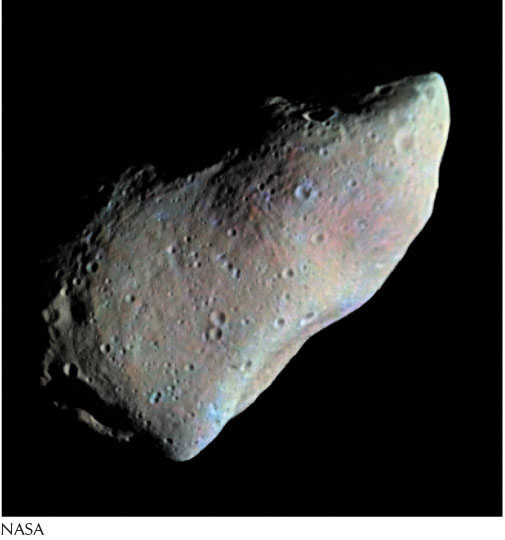
Some asteroids in the inner solar system orbit between the asteroid belt and the Sun. Many of these objects have highly elliptical orbits that take them across the paths of some of the planets, including Earth.
5-7 The infalling debris from the giant planets led to the Late Heavy Bombardment
Margin Question 5-4
Question
Pluto takes 248 years to orbit the Sun once. Are the orbital periods of the plutinos greater than, less than, or equal to 248 years? Why?
Earth, along with every other body that orbits the Sun, has been struck by countless pieces of space debris throughout its life. Indeed, these impacts still occur today. Depending on the speed and angle at which they strike land, impacting bodies larger than about 0.5 m create scars, called craters. Most of the craters on our planet’s surface have been erased, as we will study in the next chapter, but we can still see numerous ones on our Moon, as well as on nearly all the other bodies with solid surfaces in the solar system (Figure 5-8). Venus is the exception, as it is periodically resurfaced.
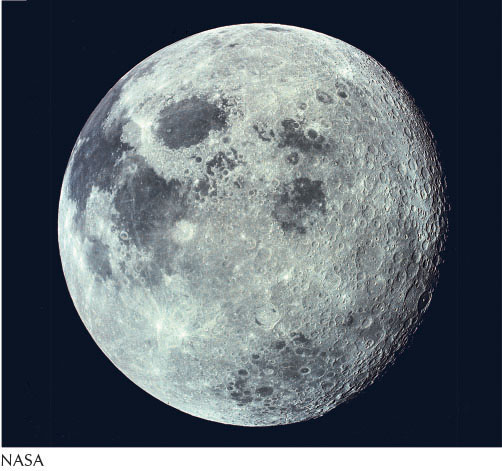
During the first 400 million years that the planets existed, the rate of impacts declined steadily. But then, about 4.1 billion years ago, the impact rate skyrocketed as planetesimals in the asteroid belt were knocked out of orbit as debris flung inward by the giant planets (see Section 5-5) struck them. Numerous asteroids were pushed into orbits that crossed the paths of the inner planets. Thus began the Late Heavy Bombardment, which ended as these errant asteroids were destroyed by either striking something, falling into the Sun, or eventually being flung out of the inner solar system.
142
The Moon was struck by so many objects during the Late Heavy Bombardment that large regions of its surface were completely obliterated, creating gigantic craters, which remained on the surface for hundreds of millions of years. These craters were eventually filled in when magma (molten rock) from inside leaked out through the thin crust below the craters, thereby forming the maria (dark plains) that we see today (Figure 5-8). Mercury, which is particularly dense when compared to the other inner planets, is believed to have lost much of its lower-density outer layers in a collision that may have also occurred during this time.
The Moon’s virtual lack of atmosphere has helped preserve important information about the early history of the solar system. Radioactive dating of Moon rocks brought back by the Apollo astronauts indicates that the rate of impacts declined dramatically about 3.8 billion years ago. That time is taken to be the end of the Late Heavy Bombardment. Since that time, impact cratering has continued, but at a very low level.
5-8 The categories of solar system objects have evolved
While it makes sense that the objects in the asteroid belt are called asteroids, the naming of bodies there and throughout the solar system is more complicated than that. Traditionally, an asteroid is a piece of space debris composed primarily of rock and metal that is larger than about 10 m (no exact minimum size has been agreed upon). Space debris smaller than this and composed primarily of rock and metal are called meteoroids. All debris that is a roughly equal mix of ice and rock are called comets. More precisely, the solid body of ice and rock that exists even when a comet has no tail is called a comet nucleus. The asteroid belt contains all three types of debris. Indeed, all the remaining planetesimals have become today’s asteroids, meteoroids, and comets.
Margin Question 5-5
Question
How might some of the meteoroids in the solar system come from asteroids?
Another layer of terminology about bodies orbiting the Sun (and by inference, any other stars) was introduced in 2006, when the International Astronomical Union redefined the term planet. According to the most recently accepted definition, a planet is a celestial body that (1) orbits the Sun; (2) has enough mass so that its own gravitational attraction causes it to be essentially spherical, rather than being a large, irregular rock in space; and (3) has enough gravitational attraction to clear its neighborhood of other orbiting debris. Planets “clear their neighborhoods” by either pulling surrounding debris onto themselves or, in some cases, flinging debris far away from their orbits. There are thus eight planets in the solar system: Mercury, Venus, Earth, Mars, Jupiter, Saturn, Uranus, and Neptune.
A dwarf planet satisfies conditions (1) and (2), but not condition (3). These objects are smaller than planets, with less mass and hence less gravitational attraction. This definition is the reason that Pluto was demoted from planet status. So far, of the myriad candidate bodies, astronomers have agreed on five dwarf planets: Pluto, Ceres, Haumea, Makemake (pronounced mah-kay mah-kay), and Eris.
A moon or natural satellite is an object orbiting a larger body that is, in turn, orbiting the Sun. Unlike ours, most moons are potato-shaped rocks. These moons are planetesimals that were captured by the various planets, dwarf planets, and asteroids. Rings of billions of dust particles and mountain-sized pieces of debris in orbit around Jupiter, Saturn, Uranus, and Neptune are yet another category of solar system object.
Everything in the solar system that is not a planet, dwarf planet, moon, or part of a ring system, is called a small solar system body (SSSB). The tricky part is that the largest asteroids are dwarf planets, while the vast majority of asteroids, as well as all meteoroids and all comets, are small solar system bodies. Figure 5-9 summarizes these relationships.

143
5-9 The Sun developed while the planets matured
During the 100 million years that the inner planets were completing their formation, the protosun was also evolving. Throughout this time, the temperature and pressure at the center of the slowly contracting protosun continued to increase. Finally, its core reached about 107 K, which is hot enough to initiate hydrogen fusion, in which hydrogen is converted into helium. Such fusion generates energy in the form of gamma rays, which, slamming into the gases in the protosun, created enough pressure inside the protosun to stabilize it. At that point, the Sun became a star. Hydrogen fusion continues in the Sun’s core today and the energy generated there over the past 4.5 billion years has maintained the Sun’s size and temperature, and thereby enabled Earth to sustain life.
Sunlike stars take approximately 100 million years to form from a nebula and settle down, which means that the Sun probably became a full-fledged star around the time the accretion of the inner planets was completed. Radiation from the Sun heated and dispersed the remaining gases in the solar system, thereby helping to limit the sizes of the planets.
Because the planets formed in a disk, they should all orbit in more or less the same plane as Earth (that is, nearly in the plane of the ecliptic). Observations bear out this conclusion. The angles of the orbital planes of the other planets with respect to the ecliptic are called their orbital inclinations, and all are 7° or less (Figure 5-10).
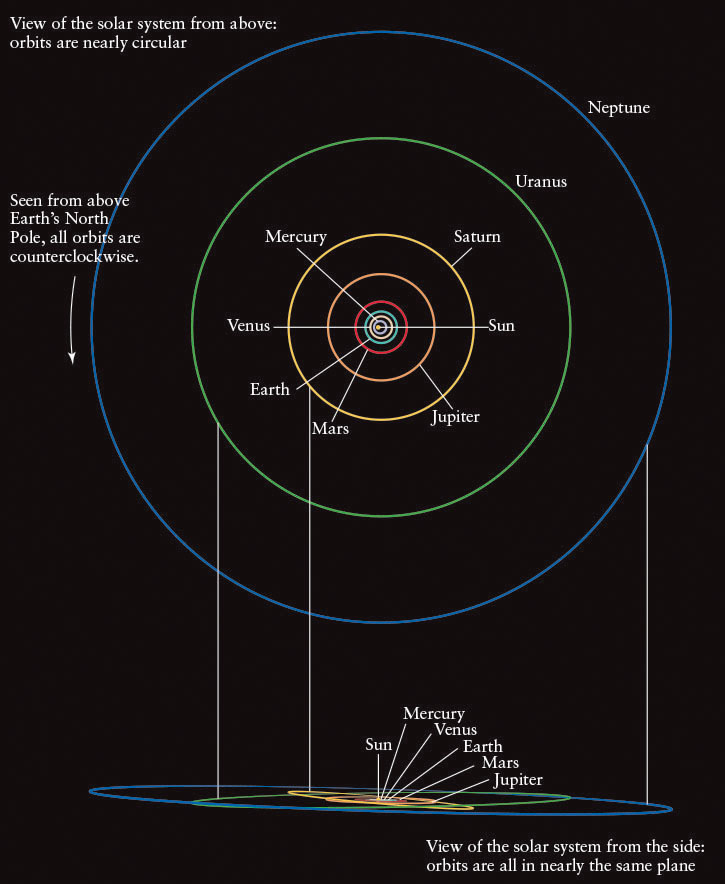
 The Solar System. This scale drawing shows the distribution of planetary orbits around the Sun. All orbits are counterclockwise because the view is from above Earth’s North Pole. The four terrestrial planets are located close to the Sun; the four giant planets orbit at much greater distances. Seen from above the disk of the solar system, most of the orbits appear nearly circular. Mercury has the most elliptical orbit of any planet.
The Solar System. This scale drawing shows the distribution of planetary orbits around the Sun. All orbits are counterclockwise because the view is from above Earth’s North Pole. The four terrestrial planets are located close to the Sun; the four giant planets orbit at much greater distances. Seen from above the disk of the solar system, most of the orbits appear nearly circular. Mercury has the most elliptical orbit of any planet.
Furthermore, according to the Nice model, all of the planets formed from the same swirling cloud of gas and dust, and hence they should all orbit the Sun in the same direction, which they do. Furthermore, since the Sun was formed from the same swirling gas and dust as the planets and other members of the solar system, it should be rotating, and the planets should be orbiting in the same direction as the Sun rotates. Imagine traveling far above Earth’s North Pole and looking down at the Sun and planets. You would see the Sun rotating counterclockwise and all the planets orbiting counterclockwise, consistent with the Nice model of how the solar system formed.
 To find out more about the solar system’s origins, astronomers study the leftover interplanetary debris: asteroids, meteoroids, and comets. Many of these bodies are thought to be virtually unchanged remnants of the solar system’s formation. According to radioactive dating of the oldest debris ever discovered from space (see An Astronomer’s Toolbox 4-2: Radioactivity and the Ages of Objects), the solar system was roughly in the form we know today just under 4.6 billion years ago. As we will see throughout the book, a lot happened between the formation of the universe some 13.8 billion years ago and the formation of the solar system, some 9 billion years later.
To find out more about the solar system’s origins, astronomers study the leftover interplanetary debris: asteroids, meteoroids, and comets. Many of these bodies are thought to be virtually unchanged remnants of the solar system’s formation. According to radioactive dating of the oldest debris ever discovered from space (see An Astronomer’s Toolbox 4-2: Radioactivity and the Ages of Objects), the solar system was roughly in the form we know today just under 4.6 billion years ago. As we will see throughout the book, a lot happened between the formation of the universe some 13.8 billion years ago and the formation of the solar system, some 9 billion years later.
144
WHAT IF…: The Solar System Had More than One Star?
We saw in Chapter 2 that Earth has a low-eccentricity orbit around the Sun. The low eccentricity keeps our planet’s temperature in a relatively narrow range suitable for the formation and evolution of life. If the Earth had formed in a binary system (one containing two stars orbiting each other), in which the two stars are relatively close together, as many are, then the gravitational tugs of the two “Suns” would force Earth into an extremely elliptical orbit, making the surface frequently too hot or too cold for most life-forms that live on Earth today.
While most of the moons in the solar system are planetesimals captured by the gravitational attractions of the planets, the larger ones that orbit Jupiter and Saturn probably formed from disks of gas and dust that orbited those worlds in analogy to the disk that orbited the Sun in which the planets coalesced. Of all the moons orbiting full-fledged planets, only one, our Moon, was created as the result of a collision between its planet and a substantial body crossing the planet’s path.
On the young Earth, one of the conditions that allowed for the beginning of biological evolution was the presence of liquid water. Strong evidence indicates that liquid water existed on Mars and may still exist inside it and inside Jupiter’s moons Europa and Ganymede, as well as Saturn’s moons Titan and Enceladus, raising the hotly debated question of whether simple life has evolved on those worlds as well.